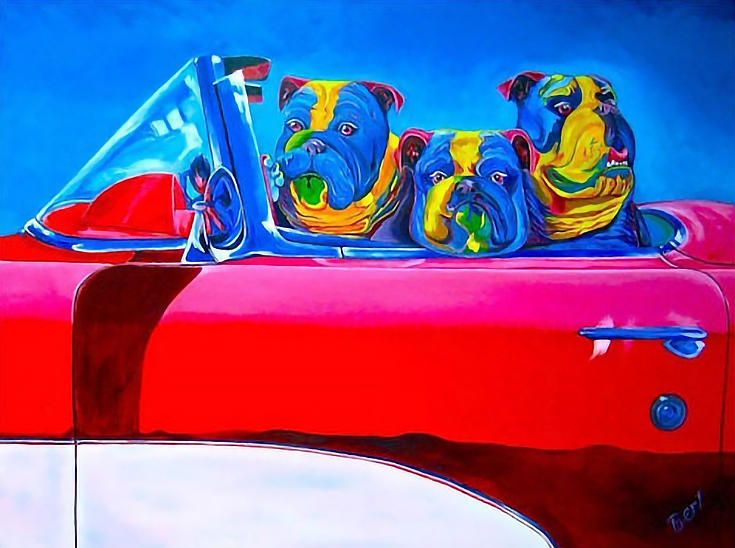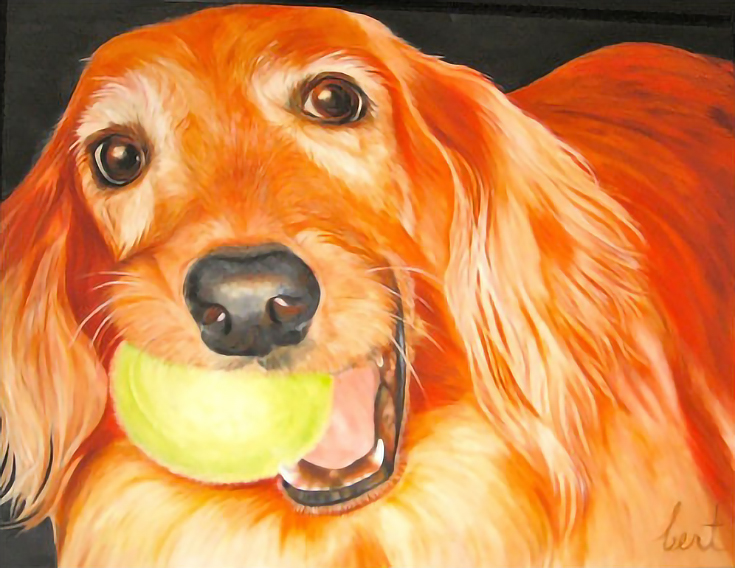 When Bert Hornbeck was in high school she entered an art competition in which she attempted to paint a soldier. When she couldn’t get the soldier to appear, she swirled the paint, creating one large nose and an eye. With that painting she won an award, and grew the confidence to keep painting.
When Bert Hornbeck was in high school she entered an art competition in which she attempted to paint a soldier. When she couldn’t get the soldier to appear, she swirled the paint, creating one large nose and an eye. With that painting she won an award, and grew the confidence to keep painting.
Today, Bert creates commissioned pieces for art collectors around the world and finds complete and utter joy in knowing that her art is appreciated because it touches the heart of her buyers.
Alyice: Why did you choose oil paints rather than acrylics as your medium?
Bert: Oils always just seemed so natural for me to be able to work with. The medium gives you time to work through different stages of a painting. It gives me the ability to create just the right blend of color and highlight to make the project perfect. It’s important for me to create depth and have the painting speak to you.
Alyice: What do you wish you knew about oils before you got started?
Bert: Perhaps more about paint thinners and poppy seed oils and varnishes that enhance the painting or change the flow of the paint while working on a larger project. It can be difficult sometimes trying to get that perfect flow going on your brush when painting hair and animal fur.
Alyice: What is the best part about working with oils?
Bert: The beauty of oils is getting that right color shading for your subjects and being able to change that one color to so many variations. A good example is painting skin tones, how they can vary so much with each subject. The ability to blend and layer colors lets me start with a basic color then add a little of this or that and go from light to having wonderful shadows.
Alyice: How do you choose the subject of your painting?
Bert: Most of my work is commissioned portraits so they choose the subject for me.
I have them send multiple photographs, then I sort through them to select the perfect one. . . one that I feel will bring my subject to life. I always want my paintings to speak to me and my client.
At this time, working with a photo with pets is really the easiest. I have looked in magazines for portrait poses more than actual subjects but when something catches your eye it may end up being a part of what you are trying to create.
I saw a gift card with a dog in a car and ended up doing a 4′ x 3′ oil of three bulldogs in a corvette that I absolutely love.
If I am creating the pose for my subject it has to be a part of their personality. . . the way I see the inner person or pet. It may not really be them, but I definitely add more interest. A sad person vs. a big smile can draw interest, a guitar in ones hand vs. a crossed arm pose says something different.
Alyice: What is your creative process like?
Bert: If I am looking for some special item I want in my paintings, I research the different ways that it may look. The internet is a good place to look for ideas. If I’m looking for a special design that will draw the eye to engage the viewer, I may pick 30 different views of the same item just to see what will draw my interest more. I do not practice techniques each day; I do not have the luxury to do this in my schedule.
Alyice: How has your style changed over the years?
Bert: My style has changed a small bit.
I started with oil paints working on only people portraits. I have continued painting them but really enjoy pet portraits. I have also branched out to oil pastels and love working with them as well. They can be a fun crazy type of painting. A new medium for me is digital drawing. It is fun, much quicker, and can have tons of color with no clean up.
I have grown to have more confidence as time has gone on and do not take the worries of being judged to get in the way of what I am doing. Just seeing the happiness in my client’s face when I deliver their portrait, or those purchasing my art at an event, have given me great confidence.
Alyice: Do you ever experience creative blocks?
Bert: There are times when a subject can be very difficult to come to life. When that happens I stop for a while to regroup or research some new ideas. . . looking for similar projects seems to help me.
Recently I was commissioned to do a black cat. My client specifically wanted him completely black as he did not have any other colors in his fur. This was a bit of a test. I worked on it for weeks and my client was thrilled. Then sometimes you have one you can’t overcome and those canvases go in the closet to be painted over someday or tossed out and set free. They can do nothing but distract you.
Alyice: What do you believe is the key element in creating a good oil painting?
Bert: Besides having good paint and a great subject, I would say it is the photograph of what I am trying to work with.
The more detail I can get and even more photos to work from, the better. Subjects do not have time to pose for a portrait any longer nor will a dog sit for more than 3 seconds to get a picture or let you draw out a quick sketch.
Learn more about Bert’s art at www.paintingpetsandpeople.com.
This post may contain affiliate links.



